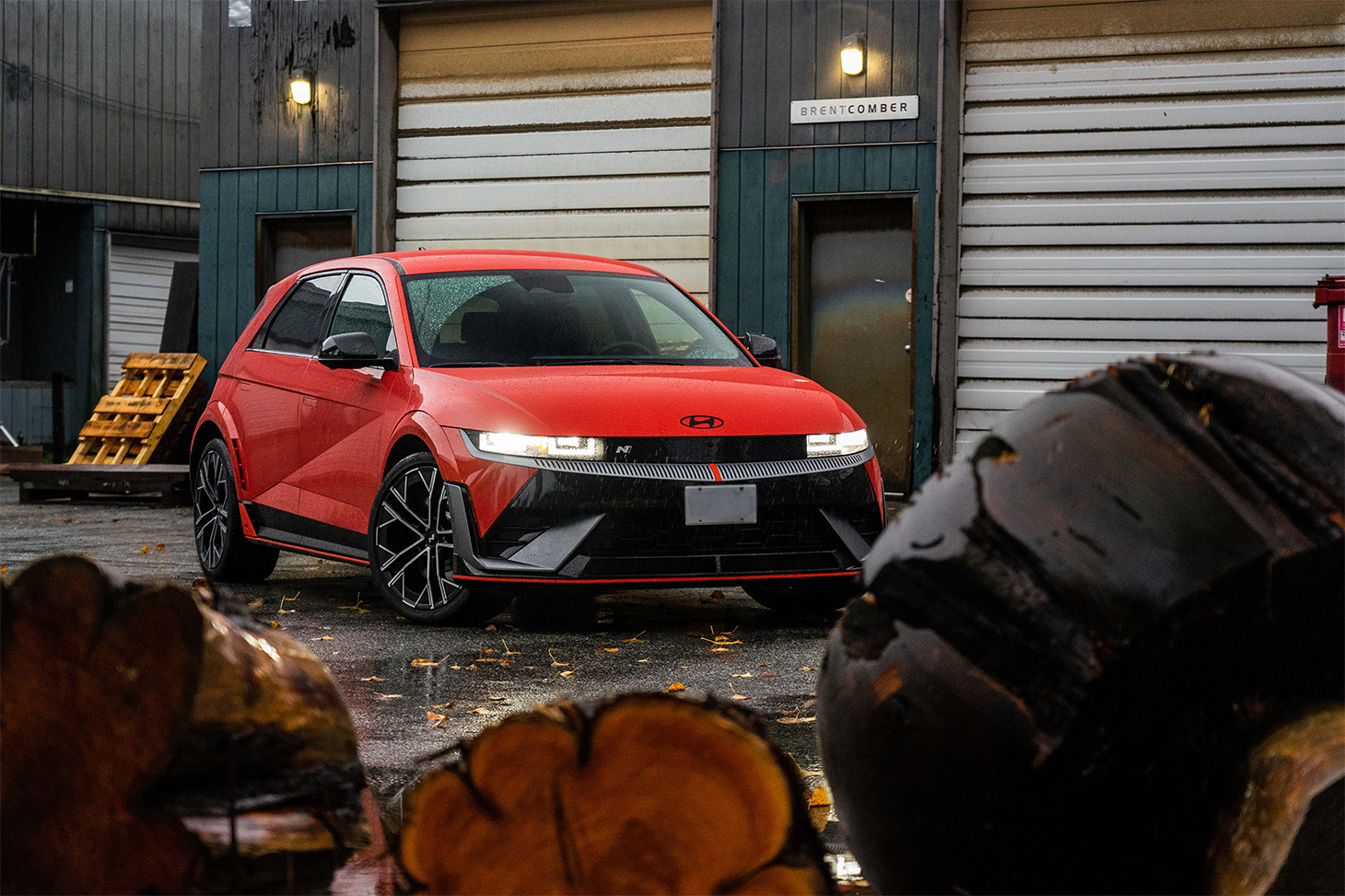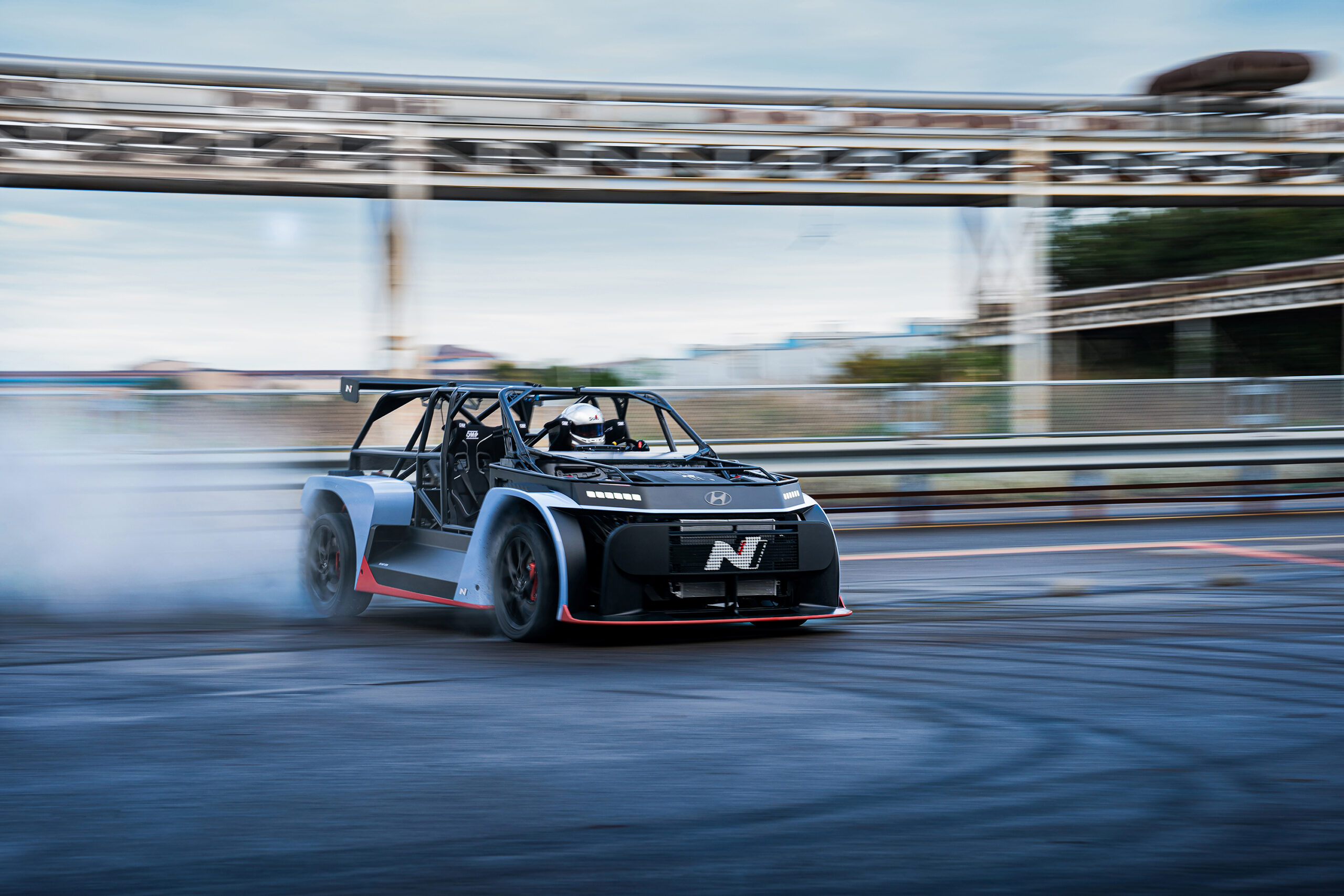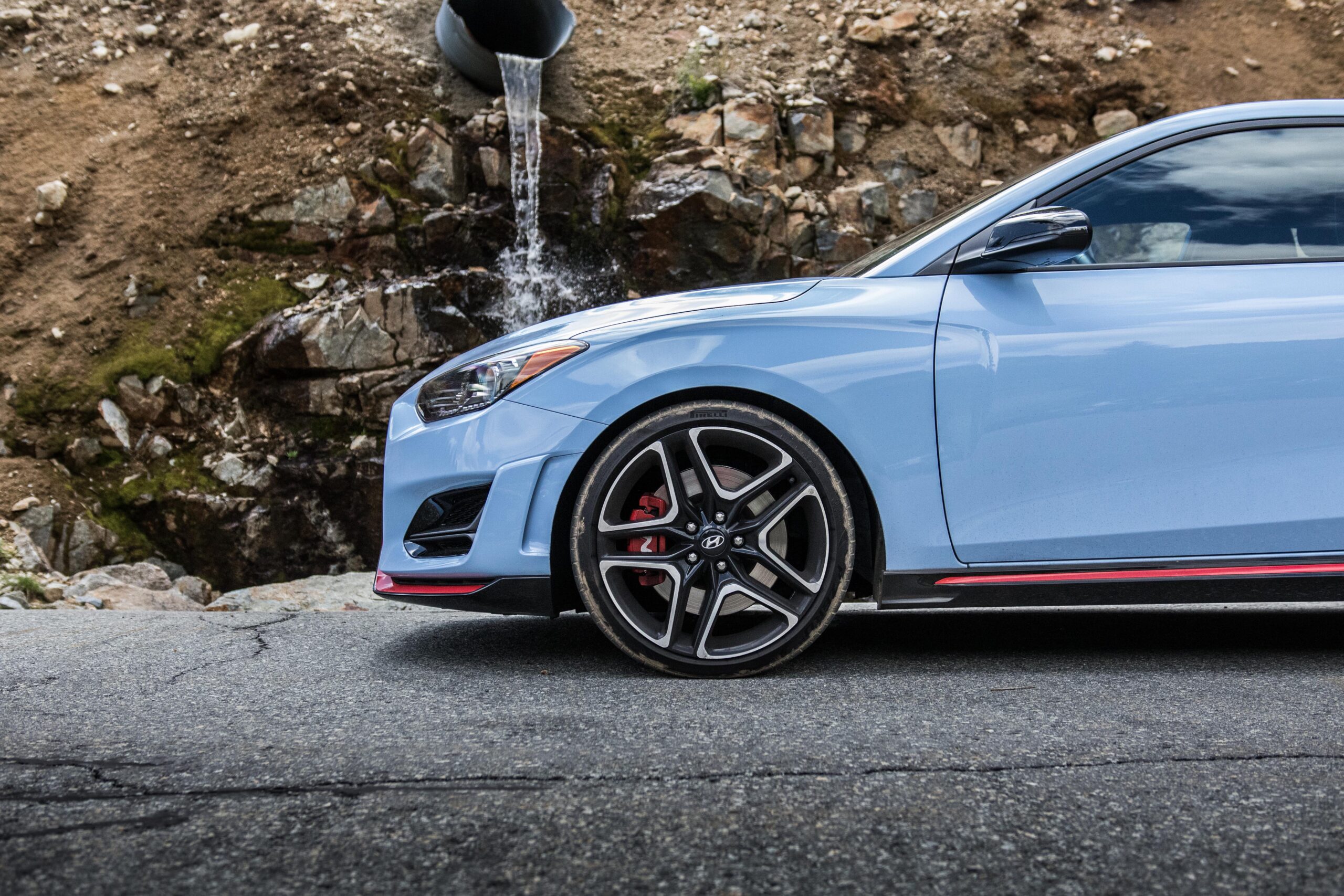A Hyundai battery electric crossover should be crisp, clean, comfortable, efficient. It should be quick to charge, spacious for passenger and cargo, and offer a driving experience that mirrors the benefits of paying a little extra for your airline seat: premium economy. Instead, this one crackles with artificial backfire like a deranged rally car, scorches down an on-ramp so quick you half-expect it to leave fiery tire tracks like the Back to the Future DeLorean, and has more horsepower than a Lamborghini Huracán.
You read that right: the company that kicked things off in this country selling the cheap and eminently disposable Pony has built a hatchback that’ll say ciao to the Italian exotics before blowing their wedgy doors off. And it’s not just the outrageous speed, either. There’s a joy here, the distilled essence of Volkswagen GTI and Subaru WRX or early BMW M3 and Mitsubishi Lancer Evo. All the great sporting compacts, reduced, decanted, and poured into a midsized Hyundai, fitted with a Star Trek warp drive. It’s called the Ioniq 5 N, and that N denotes a phenomenon you’ll want to pay attention to.

The Hyundai Ionic 5 N.
In the automotive world, some letters are spicier than others. Seeing R associated with a car, for instance, is a clue that things are going to get lively. Same with S and, thanks to BMW’s skunkworks division, M.
Wind the clock back to the early 2000s and think of Bavaria’s best machines: the potent V8-powered E39 M5, the scorching inline-6 E46 M3, or even the wonky-looking but dynamically fantastic “Clownshoe” M Coupe. Imagine working in a place where you could sign any of these thrill rides out for the weekend and go haring around the twisting roads of the Black Forest, stopping occasionally to snack on a pretzel. You’d never leave, right?
Unless you were Albert Biermann, the former head of BMW M who left to run Hyundai’s N division. Biermann grew up as a fan, waving a BMW flag at touring car races held at the Nürburgring in the 1970s, then worked as a chassis engineer on the boxy, iconic first-generation M3 racing cars. But he saw something in the way the South Korean automotive industry was advancing so rapidly. When Hyundai first came calling, the answer was no, but as BMW M became more integrated into the corporate mothership, Biermann wanted to be around the wild projects again.
Hyundai’s N division takes its name from two places: the aforementioned Nürburgring, battleground for Porsche 911s and Chevrolet Corvettes, and Namyang, the suburb of Seoul where Hyundai’s R&D offices are located.
The first road-going N car you could buy was the Veloster N, an asymmetrical, three-door hatchback with a 275-horsepower turbocharged 2.0-litre engine, front wheel drive, and your choice of either a six-speed manual or a dual-clutch eight-speed automatic. The engine lacked character. The car’s silhouette was weird. Even so, it was utterly sublime to drive, a corner-happy rascal fizzing with mischief. In 2020, Road & Track voted the Veloster N its performance car of the year, ahead of luminaries like the Porsche 911, Lotus Evora, and Toyota Supra. The Hyundai didn’t outcompete the heavy-hitters on numbers—it just put a bigger smile on your face.
When the Veloster was dropped from the lineup a few years back, the N badge next found its way onto the previously unremarkably competent Elantra sedan. The Elantra N was more serious, more precise in its dynamics than the Veloster N had been, which came in handy when Hyundai turned it into an actual racing car.
Feel free to wave the maple leaf flag here a bit, as one of the two drivers who handed Hyundai the 2023 IMSA TCR championship was Robert Wickens, who was born and raised in Guelph, Ontario. Paralyzed from the waist down as a rookie in an IndyCar crash seven years ago, Wickens co-drove the Elantra N TCR using hand controls. He praised the chassis not just for its speed but also its reliability—to finish first, you must first finish.
Meanwhile, at this year’s Nürburgring 24 Hours race, the Elantra N swept the podium in its class. Hyundai’s N division set up its spectator headquarters trackside on the very spot BMW used to occupy, flying over Gran Turismo creator Kazunori Yamaguchi to announce a partnership between their brands. Also revealed was a wildly bewinged hill-climb version of the Ioniq 5 N, which went on to set a record at the century-old Pikes Peak International Hillclimb.
Victory on the track is one thing, and it pleases the hardcore fans. You can walk into a Hyundai showroom right now and buy a practical and family-friendly sedan that’s related to championship-winning cars. If you want to wait, Hyundai is even bringing an Elantra N TCR to market, complete with a massive rear wing like you’d get on a GT3, but the Elantra N costs a fraction of the price.
But perhaps more important than winning is the culture of a company, and Hyundai’s N division is crammed with enthusiasm. Vice-president Joonwoo Park will, if pressed, rattle off previous ownership of all kinds of desirable sheet metal from sporting brands, from AMG E55 bruisers to twin-turbo Nissan 300ZX.
Every year or so, N’s engineers unveil a rolling laboratory of speed. Previous hits have included a mid-engined Veloster, a reimagining of a 1974 Pony Coupe concept car powered by a hydrogen fuel cell, and the most recent, dubbed RN24, which grafts the Ioniq 5 N’s power unit to a rally car exoskeleton with no roof, doors, or hood. In the press release, the driver is never not doing massive four-wheeled burnouts. These are the eccentric projects that lured Biermann back to Hyundai after retiring from the N division.

The Hyundai RN24.
From behind the wheel of the road-going Ioniq 5N, you can feel their echoes. You can choose to run this car as you would any performance EV, silent and viciously bending the rules of physics, or you can press a button and it gurgles like a straight-piped 1990s hot hatchback, complete with simulated gear shifts that wallop you in the kidneys like a penalty-drawing NHL back-check. There is no point to this mode of driving other than its comedic value. It’s all about having a good time.
The electric car revolution once seemed set to leave ordinary automotive enthusiasts behind. The cars were clinically quick and soulless, as charming as an iPhone. The likes of the friendly-faced Rivian and just-announced VW Scout give a little hope to outdoorsy offroad types, but it’s Hyundai’s N that calls out to the gearheads. “We’re with you,” it says, “We’ve got your back. We put something called Drift Mode in our EV crossover for you. Want to find out what it does?”
Sure do.









